The categories and types of special economic zones, free trade zones and just plain free zones sometimes can seem as numerous as the zones themselves. Their boundaries can shift and jump depending on community and company needs. And even as some zones merge or disappear (Mexico’s government repealed several SEZs late last year) new zones are being formed and named all the time. China’s State Council in September, for instance, announced that it will establish three new pilot free trade zones (FTZs) in Beijing, Hunan, and Anhui and expand the FTZ in Zhejiang.
As explained by Dezan, Shira & Associates, “pilot free trade zones are areas marked out by the government where a series of test policies are trialed, such as tax cuts, streamlined customs clearance, and/or industry-specific liberalization, which will be replicated and scaled up to the national level if they are successful. This is the seventh batch of FTZs announced since 2013, taking China’s total tally to 21 free trade zones spread across the country.”
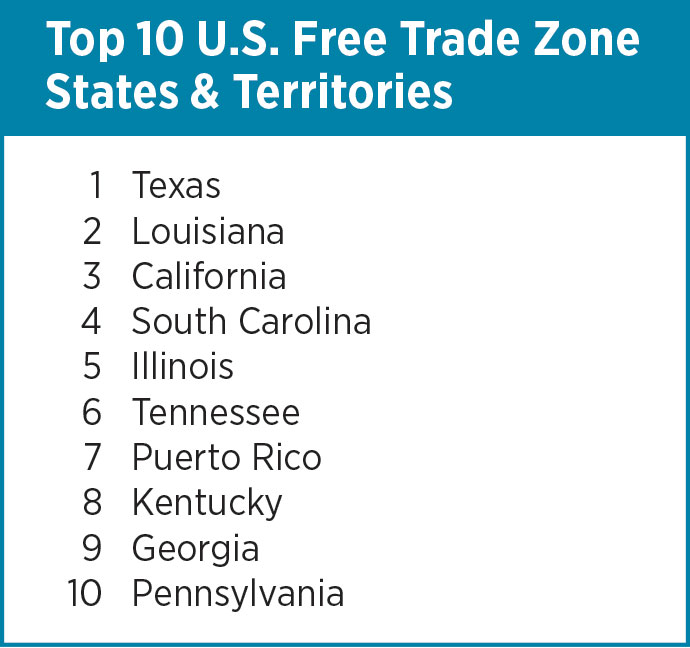
That nomenclature, however, does not count the hundreds of export processing zones and other free zones across China. So the age-old question arises: How can we compare performance?
For some areas of the world, the data is sparse, to say the least. For others, it just takes a little work. Take the United States, for example. We took numbers from the 80th Annual Report of the Foreign-Trade Zones Board to the U.S. Congress (published in November 2019) and ran calculations based on a number of Top 25 rankings derived from the zones’ 2018 operations data to calculate the index of Top 10 U.S. FTZ States & Territories you see on this page.
Among the highlights in the FTZ Board’s report to Congress at the end of last year:
- There were 195 FTZs active during the year, with a total of 330 active production operations. Over 440,000 persons were employed at some 3,300 firms that used FTZs during the year.
- Among the Board’s 88 decisions were the reorganization or expansion of 19 zones under the alternative site framework (ASF), which allows zone boundaries to extend to particular nearby locations where companies are investing. The Board also made decisions on 64 applications and notifications for new or expanded production authority.
- The value of shipments into zones totaled over $793 billion, compared with over $669 billion the previous year. About 63% of the shipments received at zones involved domestic status merchandise. “The level of domestic status inputs used by FTZ operations indicates that FTZ activity tends to involve domestic operations that combine foreign inputs with significant domestic inputs,” the report said.
- Exports from facilities operating under FTZ procedures amounted to over $112 billion. (The export figures do not include certain indirect exports involving FTZ merchandise that undergoes further processing in the United States at non-FTZ sites prior to export.)
Rare Cargo
Perennial leader Texas tops the charts again, led by top-performing zones in the Corpus Christi and Houston areas. But while zones are most frequently found at coastal ports, that is not a requirement. Nor is it required that huge amounts of cargo move around. Sometimes the cargo is small and precious. Take the case of a new headquarters in Dallas-Ft. Worth.
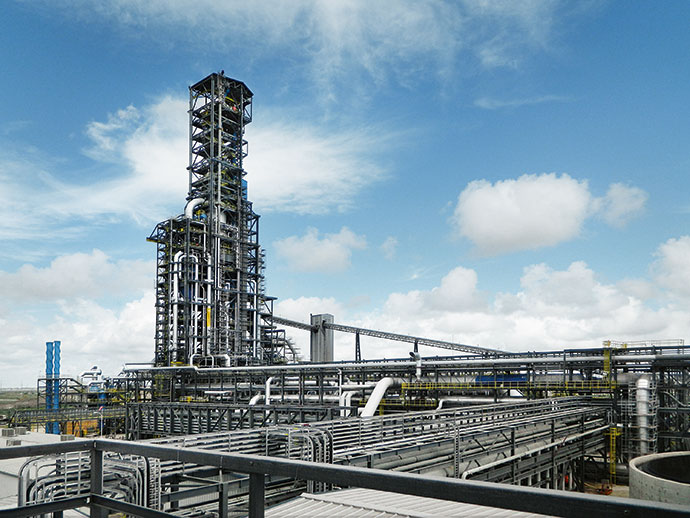
Heritage Auctions in June announced it had moved its global headquarters into a new 160,000-sq.-ft. facility and multi-purpose campus, befitting its status as the largest auction house founded in America. The move consolidates three Dallas locations under one roof on Airport Freeway adjacent to Dallas Fort Worth International Airport and in its foreign trade zone. The single-story complex spans the length of nearly three football fields. Nearly 450 of Heritage’s more than 600 employees will occupy its new headquarters.
Heritage is the world’s largest collectibles auction house — a global leader in coins, comic books, sports and entertainment memorabilia, and 37 other categories. In recent years, however, the company has made dramatic and significant expansions into the realms of fine art, fine and rare jewelry and timepieces, luxury handbags, rare wines and historic nature and science artifacts. In the age of e-commerce, Heritage is ahead of the game too, with the highest online dollar volume of any auction house on the planet, with a website, HA.com, that has more than 1,250,000 registered bidder-members and searchable free archives of five million past auction records with prices realized, descriptions and enlargeable photos. (Explore those archives and try to limit your curiosity to just 20 minutes. I dare you.)

The move to the expansive new facility and its 8,000-sq.-ft. gallery showroom for events will increase operational efficiencies and allow Heritage to better serve its more than 1 million clients from around the world. Indeed, global commerce in FTZs comes in all shapes and sizes.
“We are excited to now be in the middle of Dallas-Fort Worth near one of the world’s largest airports,” said CEO and Co-Founder Steve Ivy. “This location and facility will better serve all of our clients, including bidders and consignors who visit our showrooms or consign with us.”
“After reviewing all available options, Heritage Auctions decided to start with a clean slate under one location that still allows for superior worldwide customer service to clients,” said Transwestern Real Estate Services Principal Nora Hogan, who facilitated the move with help from several team members and a key assist from Bill Methenitis, an FTZ consultant with EY. “Located at the intersection of two major highways, this space allows Heritage to easily serve out-of-town clients as well as DFW residents who need appraisals. This location also allows them to serve the metroplex while keeping a Dallas address, which is where the company started and is considered an integral part of the Heritage legacy.”
Hogan shares an example of FTZ cost savings through customs clearance.
“Assuming a full container value is $230,000 in inventory, the cost to clear an entry in the FTZ based upon this value is $485.00,” she explains. “An entry is one or more containers, but if multiple containers, they must arrive at the same place and at the same time. This cost is the same whether you are in the FTZ or not. However, if you are in the FTZ, the containers can be grouped per week whether they arrive at the same time and at the same place.
“Therefore, assuming two entries per day or 10 per week, if you are in the FTZ, you would save based on nine entries per week not being counted — or 468 per year — which represents a savings of $227,000 per year (468 x $485.00). If five (5) entries per day or 25 per week, you would save 1,248 non counted entries per year (24 per week x 52 weeks) which represents a savings of $605,000 per year (1,248 x $485.00).”
And Now the Nominees for Outstanding Individual Performance
Speaking of math, we worked more out of the raw data figures grabbed from little boxes throughout individual zone entries in the 162-page U.S. FTZ report PDF. Using figures representing ranges of merchandise received, exports and jobs at all 257 FTZs across the nation, we devised an indexed ranking representing the Top 20 U.S. FTZs in Combined Economic Impact.
FTZ 122 in Corpus Christi, Texas, tops the list. Regular Site Selection readers are familiar with the level of production activity that transpires there. The port in July recognized Buckeye Partners L.P. for achieving a historic milestone in its South Texas Gateway (STG) Terminal project — loading the first vessel with crude oil sourced from the Permian Basin for export to overseas markets. STG is a joint venture 50% owned and operated by Buckeye Partners. Phillips 66 Partners LP and Marathon Petroleum Corporation each have a 25% ownership interest. When fully operational, STG’s petroleum products storage capacity will be 8.6 million barrels, with the potential to expand to 10 million barrels, and up to 800,000 barrels per day of throughput capacity at two deepwater docks.
“South Texas Gateway represents a significant investment in the Port of Corpus Christi and a long-term commitment to our customers,” said Khalid Muslih, executive vice president of Buckeye GP and president, Global Marine Terminals. “Our employees and contractors continue their efforts to safely and efficiently complete the additional phases of construction on this project, which we expect to be fully complete by the first quarter of 2021. This world-class facility will play a critical role in serving global energy markets from South Texas and the Port of Corpus Christi.”
At Port Houston, home to our No. 3 FTZ (FTZ 84), August container volumes were way up after monthly year-over-year declines for all months since the pandemic struck in March. Data from PIERS, a provider of import/export data, indicated that Port Houston had the smallest decline of the top 10 container ports in the United States.
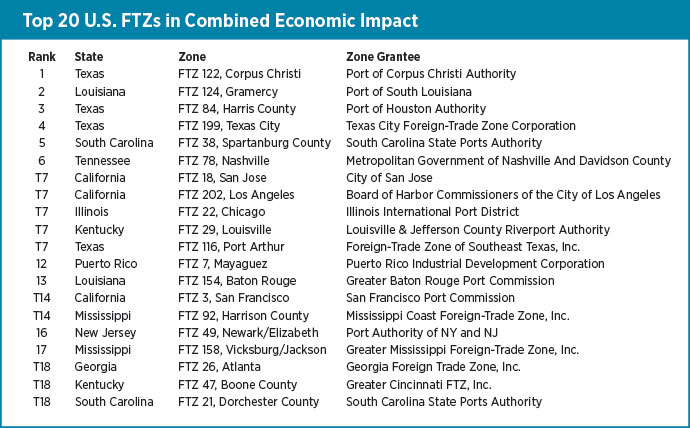
“Import containers have been strong and we’ve seen a large number of extra loaders this peak season as retailers in our region replenish inventories, and those extra loaders have helped balance the impact of blank sailings,” said Port Houston Executive Director Roger Guenther in a September release. “Port Houston’s fundamentals remain solid, there’s been strong activity in construction and expansion of e-commerce distribution centers that support imports and also resin packaging capacity to support exports. For example, this summer, Frontier Logistics completed a half-million-square-foot, rail-served warehouse adjacent to Barbours Cut Container terminal, which is another boost to our regional manufacturing base.”
Two inland locations support our fifth- and sixth-ranked zones, FTZ 38 in Spartanburg, South Carolina (i.e. BMW) and FTZ 78 in Nashville (i.e. Nissan). Meanwhile, our seventh-ranked U.S. zone, FTZ 18, is found in San Jose, California. No, it’s not just driven by tech giants. Among the FTZ Board notices in the Federal Register last year was a notification of proposed production activity from Tesla for its facilities within FTZ 18 Subzone 18G, in Fremont, Livermore, and Oakland, California.
The View from Amsterdam
If you’re looking for a global perspective on zones and trade, Amsterdam is a good place to start. That’s where you’ll find Zoë Harries, managing director of boutique foreign trade and investment advisory firm Impact Zones and chair of the advisory board for FEMOZA – the World Free & Special Economic Zones Federation. Impact Zones specializes in sustainable SEZ development.
“Our main activity has been in Africa, the Middle East and Europe in recent years,” she says, “with a bit in the Caribbean.”
In consultation with World Bank, FEMOZA is launching an initiative to create a directory of SEZs that will track all 4,500 zones worldwide, and make available to the public a version that will have some 2,500 zones listed, including various incentives and legal frameworks, utilities and other relevant characteristics. As for tracking activity and categories of zones, well, “it’s like a jungle out there,” she jokes. But corporate activity in zones provides some signposts.
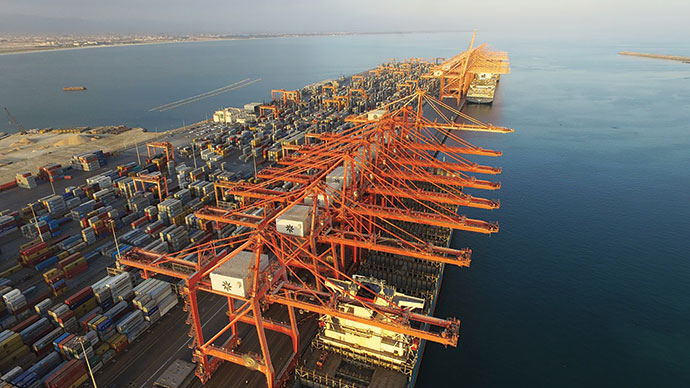
For one, corporate social responsibility metrics are becoming more and more important, she says, citing Unilever as a leader in this area.
“It’s been proven that impact investment is more profitable than traditional investment,” she says, and a sustainability profile enables greater access to funding. “For the development of new zones, there is much more funding from development finance institutions,” she says, “and for the companies moving into the zones, impact investment is the fastest form of finance.”
One example Impact Zones is involved with is moving forward from Nestle, which is looking to make a stronger social impact in Ghana, where the cocoa industry is king and four export processing zones help keep it that way. The project team was examining how to help farmers increase revenues and become more resilient, and found there was a pulp byproduct, previously discarded, that could be made into a fruit juice. Now it’s marketed as Kumasi.
“The farmer can now sell the cocoa to Nestle, process the pulp for the fruit juice, and they’re exporting the juice through one of the zones,” she says. “They’re thinking about setting up a new zone around this project. This has been supported by Nestle.”
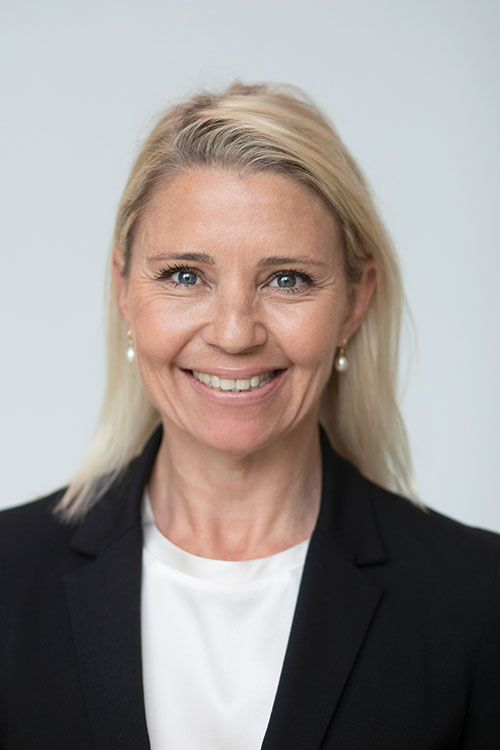
Harries says traditional business park zones have been set up on a legal framework in terms of taxation and ownership, and were often initiated by real estate developers with a “build it and they will come” philosophy, “almost like an offshore destination,” she says. “This has changed now, because zones cannot rely anymore on the legal framework alone. They’re not competitive enough on just the incentives they’re offering. Most competitive zones realized this a while ago, and started competing in terms of services innovation. The zones who have understood that are now the most successful. They’ve become also more independent of the national governments in terms of becoming a top-notch industrial business park.”
What are some of those innovative services?
“If it’s a logistics hub, support of digitalization of the documentation process,” she says. “We’re now developing a model for digitalization of ports and the logistics procedure system as a zone. You need flexible solutions in terms of what zones offer, so companies can move into larger or smaller facilities. Some are having a person look at companies’ supply chains and anticipating and facilitating needs for the company. They’re offering more B2B services. They’re creating a network or cluster within the zone, partnering with other zones, and thinking outside of the zone.”
That means focusing on a bigger ecosystem picture, including collaboration with local universities, and assisting with workforce needs from transportation to child care to supermarkets and financial services. The old export processing zone concept is thus evolving into a high-tech park.
“With new zones, there is an urban planning element as well,” she says, “so that they will become towns with shopping, medical care and schools. We’re getting a smart city hybrid with the zones.”
She says one interesting development is increasing involvement in zone development from utility and power supply companies.
“We’ve seen recent examples in Africa and Europe. The energy companies are seeing the value in terms of diversifying the client portfolio.”
Energy-intensive companies can often secure a more competitive price and better reliability by locating in the zones. Harries’ team is working with Richards Bay Industrial Development Zone in her native South Africa on a unique project in this sphere that is an example of tenants working with zone management to devise solutions.
“One of their major tenants requires a lot of power, and a manufacturing facility has come up with a solution to generate electricity and redistribute surplus energy within the zone at a competitive price,” she says.
Global View
The difficulty of evaluating the rest of the world’s 5,400-plus zones is gargantuan, and has been well documented in these pages over the years. Not only is it challenging to find apples-to-apples comparisons, it’s also hard to find basic data. But from 2010 to early 2018, corporate facility locations and their capex and job creation figures were tracked by Investment Consulting Associates (acquired by Site Selection publisher Conway Data). And looking back, we saw that the data had never before been analyzed on a per-capita basis.
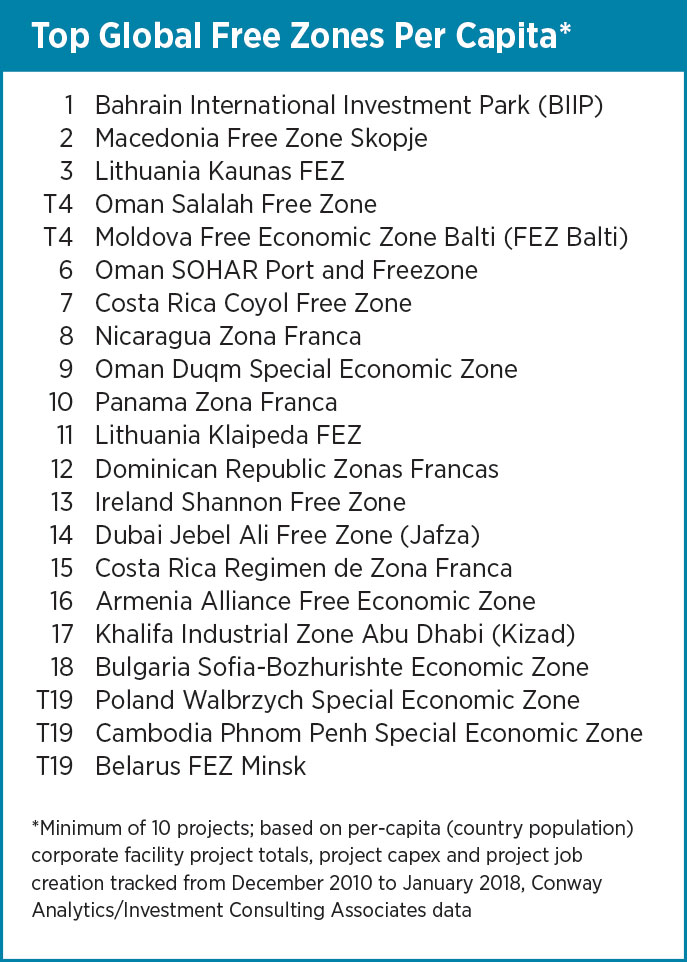
So the ranking presented here does just that, for zones and zone programs with a minimum of 10 projects. While these top 20 and ties offer a diverse array of world geographies, it’s worth noting that four of the top 10 are in the Middle East, including No. 1 Bahrain International Investment Park and three zones in Oman.
Four of these top zones are in Latin America. And eight are in central and eastern Europe. The one zone in this elite group from western Europe is the granddaddy of all zones, Ireland Shannon Free Zone, launched in 1959 to lure foreign investors with tax breaks.
Among recent world zone highlights from FEMOZA, the World Free Zones Organization (WFZO) and various zones’ newsletters:
- The president of the Dominican Association of Free Zones (Adozona) said zones have demonstrated operations recovery after the impact of COVID-19, with some sub-sectors showing higher levels of employment than they had before the pandemic. Dominican Republic President Luis Abinader recently inaugurated a Scotiabank facility in a free trade zone that will generate 2,000 jobs. The $80 million project is the company’s second Latin America campus, with the mission of exporting support services to Scotiabank operations around the world.
- Tanger Med Port in Morocco has welcomed investments from companies such as Nippon Express France. Situated adjacent to one of the largest container ports in Africa, the Tanger Free Zone (TFZ) boasts about 800 tenant companies. Automobile and automotive parts manufacturers and other automotive-related companies from around the world — including many automotive parts companies from Japan — have set up production facilities in the TFZ. Morocco’s government has in recent years been pursuing strategic policies aimed at enhancing the country’s status as a logistics hub for North and West Africa, with Tanger Med Port located in northern Morocco serving as a key gateway.
- Construction has begun on Uganda’s first public free zone. And Djibouti is pursuing construction of the largest free trade zone in Africa, in a country that controls the Bab el-Mandeb (“Gate of Tears” in Arabic), a crucial chokepoint in the Horn of Africa at the entrance to the Red Sea and the Suez Canal from the Indian Ocean.
- In Pakistan, 13 Special Economic Zones will be set up to introduce industrial renaissance in South Punjab.
Present Tense, Future Promise
The Freezone World Economic Barometer (F-WEB), established in early 2018 by the Kiel Institute for the World Economy in Kiel, Germany, is a sentiment indicator put together with the World Free Zones Organization and designed to gauge the current momentum of economic activity in free zones and offer indications about future trends based on quarterly questionnaire responses.
In its most recent note after Q2 2020, the report said that due to the pandemic and measures taken to contain the spread of the virus, “economic conditions in free zones have deteriorated markedly. The share of free zones reporting good economic conditions decreased drastically from 56% in this year’s first quarter to 15% now. About 49% evaluate their current situation as normal and 36% as poor.
But long-term prospects may be more sanguine. UNCTAD’s World Investment Report 2020, released in June, had some cogent observations about the role of free zones:
“Special economic zones (SEZs), an industrial policy tool that relies on the attraction of FDI, continue to proliferate and diversify around the world,” the report noted. “There are now more than 5,400 SEZs across nearly 150 economies, up from 4,000 in 2015, and hundreds more are in the planning stage. They are both a response to and a cause of increasing competition for FDI between countries and regions. Moreover, industrial policies are increasingly targeting industries considered strategic not only for job creation and long-term economic growth and development prospects, but also for (broadly interpreted) national security reasons. The strategic importance of the pharmaceutical and medical equipment industries, for example, with their reliance on cutting-edge research and innovation, could see progressively more countries enacting policies to develop national productive capacity.
“A survey of industrial policies adopted over the last 10 years in more than 100 countries showed that the vast majority of them aim to attract international investors in priority sectors through changes in investment laws, facilitation measures, incentives schemes and special economic zones,” the report said.
Indonesia, where FDI inflows recently surged by 14% to a record level of $23 billion is a case in point. Uzbekistan, where FDI inflows more than tripled in 2019 to $2.3 billion, is another. In addition to setting up a legal framework for public-private partnerships and other FDI- and business climate-focused policies, the country in February 2020 adopted a law on SEZs.
UNCTAD’s report in 2019 found that more than 1,000 zones had been created in the previous five years, with at least 500 more in the pipeline.

